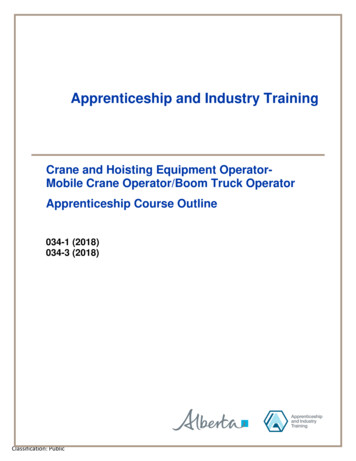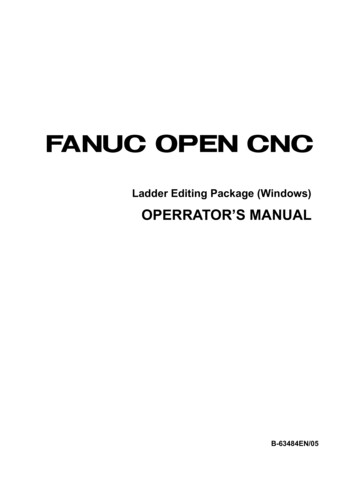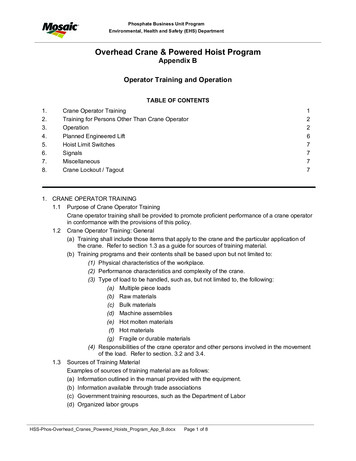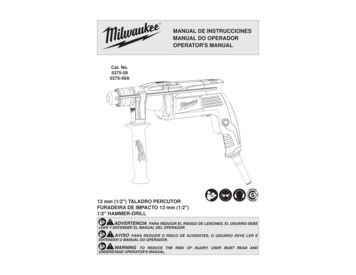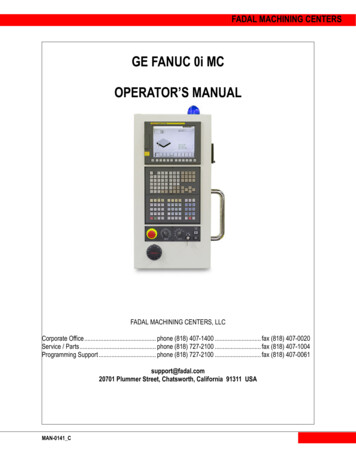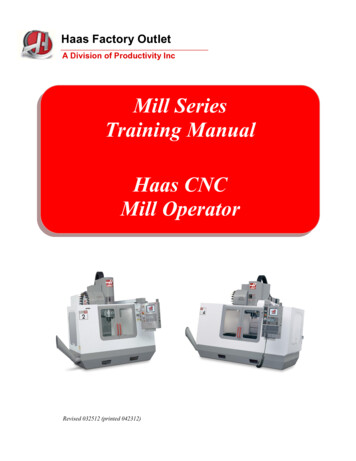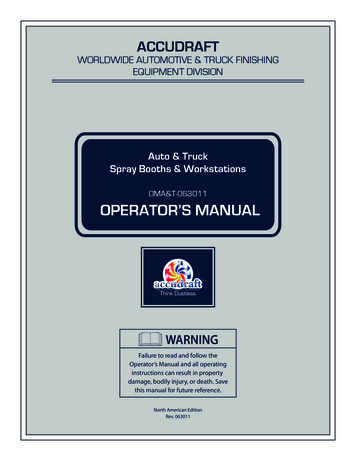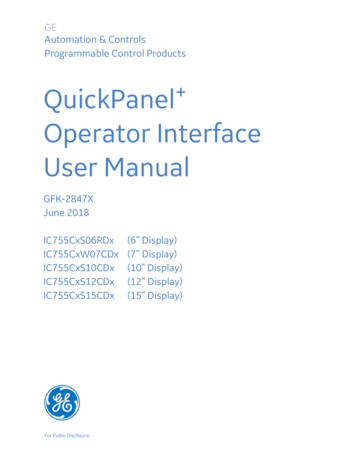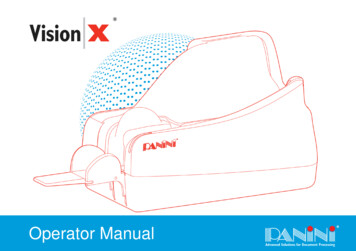
Transcription
Operator ManualOPERATOR MANUALPage 0General
Panini Vision XOperator Manual
CONTENTS0. Preface1. General1.1 Audience1.2 Safety Precaution1.3 If the machine is damged2. Learning about the Panini Vision X2.1 Packaging List2.2 External Parts Description2.3 internal Parts Description3. Operating your Panini Vision X3.1 Document Support Installation3.2 Extension Plate Installation3.3 Power Cables Connection3.4 USB2 Cable Connection3.5 Ink-jet Cartridge Installation3.6 Pocket Length AdjustmentOPERATOR MANUALPage 2Preface
4. Getting Started4.1 Status Light4.2 How to Prepare and Load Checks4.3 Clearing Jams5. Maintance5.1 Cleaning the Transport5.2 Cleaning the Contact Image Sensors5.3 Cleaning the Ink-Jet Cartridge5.4 Cleaning Photocells Detector5.5 Replacing the Feeder and Separator Roller5.6 Cleaning the Reading Transport Belt5.7 Install the External Covers6. Specifications6.1 Technical Specifications of the Panini Vision X6.2 Technical Specifications of the PC7. Vision X AGP Addendum8. Vision X P Addendum9. Multilingual WEEE Disposal Procedure and Safety PrecautionsOPERATOR MANUALPage 3Preface
Fourth Edition,July 2011 2011PANINI SpAVia Po, 3910124 Torino, ItalyPANINI NORTH AMERICA(Subsidiary)577 Congress Park DriveDayton, OH 45459USAPANINI LIMITADA(Subsidiary)Rua Joaquim Floriano,871 – 11ºASão PauloBrazilThis manual and the software described in it are protected underthe Panini S.p.A Copyright. All rights reserved. Reproduction ofthismaterial in any form without the express written consent ofPanini SpA or its subsidiaries is prohibited.PANINI SpA PROVIDES THIS MANUAL “AS IS” WITHOUTWARRANTY OF ANY KIND, EXPRESS OR IMPLIED, INCLUDING,BUT NOT LIMITED TO THE IMPLIED WARRANTIES OFMERCHANTABILITY AND FITNESS FOR A PARTICULARPURPOSE. PANINI SpA MAY MAKE IMPROVEMENTS AND ORCHANGES IN THE PRODUCT(S) AND OR THE PROGRAM(S)DESCRIBED IN THIS MANUAL AT ANY TIME AND WITHOUTNOTICE.This manual could contain technical inaccuracies or typographicalerrors. Changes are periodically made to the information herein;these changes will be incorporated in new editions of thispublication.www.panini.comOPERATOR MANUALPage 4Preface
Trademark AcknowledgementPANINI, Vision X, Vision API, ICR Vision and MICR Plus are trademarks or registered trademarks of PaniniSpA.The markaffixed to the product certifies thatthe product satisfies the basic quality requirements.The Panini Vision X is also UL 950 compliantNOTE: This equipment has been tested and found to comply with the limits for a Class A digital device,pursuant to Part 15 of the FCC Rules. These limits are designed to provide reasonable protection againstharmful interference when the equipment is operated in a commercial environment. This equipmentgenerates, uses, and can radiate radio frequency energy and, if not installed and used in accordance withthe instruction manual, may cause harmful interference to radio communications. Operation of thisequipment in a residential area is likely to cause harmful interference in which case the user will be requiredto correct the interference at his own expense. 2011 PANINI S.p.A., ALL RIGHTS RESERVEDOPERATOR MANUALPage 5Preface
Proper Disposal of WEEEFOR COUNTRIES IN THE EUROPEAN UNION (EU)The European Commission of the European Union has determined that electrical and electronic equipmenton the market today contain parts and components that may be properly reused or recycled to reducequantities of materials ultimately disposed in landfills and other disposal arenas. To address thisdetermination, waste electrical and electronic equipment (WEEE) should not be collected or disposed withunsorted waste from private households or businesses. Rather, it must be collected separately. Dumping ofthese devices at unequipped and unauthorized places may have hazardous effects on health andenvironment. Offenders will be subjected to the penalties and measures laid down by the law.To that end, Panini products are appropriately marked with the European Union WEEE Directive’scrossed-out dustbin symbol to indicate the requirement for separate collection of electrical andelectronic equipment put on the market after August 13, 2005, according to the WEEE directive2002/96/EC (and subsequent amendments) and your national laws.To dispose of our devices correctly: Contact the Local Authorities or local distributor, who will give you the practical information you need andthe instructions for handling the waste correctly, for example: location and times of the waste collectioncentres, etc.When you purchase a new device of ours, give a used device similar to the one purchased to ourdistributor for disposal.FOR OTHER COUNTRIES (NOT IN THE EU)The treatment, collection, recycling and disposal of electric and electronic devices will be carried out inaccordance with the laws in force in the country in question.OPERATOR MANUALPage 6Preface
0. PrefaceHere is an overview of the manual layout:Chapter 1: “General” introduces you to all the general information regarding the manual or the PaniniVision X.Chapter 2: “Learning about Panini Vision X” introduces you to all the major components of your machine.Chapter 3: “Operating your Panini Vision X” describes simple installation procedures.Chapter 4: “Getting started” explains how to operate the Vision X.Chapter 5: “Maintenance” describes how to solve problems that you may encounter using this machine.Chapter 6: “Specifications” lists the main functions of the Vision X and the features of the PC.Chapter 7: “Vision X AGP Addendum”Chapter 8: “Vision X P Addendum”Chapter 9: “Multilingual WEEE Disposal Procedure and Safety Precautions” explains how to disposethe Vision X in 12 languages.OPERATOR MANUALPage 7Preface
1. GeneralCongratulations on your selection of the Panini Vision X!The Panini Vision X is the next generation check scanning platform designed specifically for distributedcheck capture.With a small footprint, sleek design and quiet operation, the Panini Vision X series is the ideal choice for awide array of applications such as: Teller Window, Back Counter, Remote Deposit Capture, MicrofilmReplacement, Cash Vault, Brokerage Houses, Accounts Receivable Conversion (ARC), just to name a few.The Panini Vision X incorporates the latest, state-of-the-art technology and the latest standards for checkprocessing in the marketplace. It is characterized by its ease of use and scalability.Panini Vision X image capture capabilities have been optimized in order to guarantee image integrity andperfect data readability despite variations in documents processed, operational skills, environmental andusage conditions.MICR reading technology available with the Panini Vision X is comparable to the larger and faster readerTMsorter, thanks to the Panini MICR Plus technology.Taking advantage of the most up to date technology, the Panini Vision X connects to computers via USB2.0interface, allowing for fast data transfer at no additional cost.A rear Ink-Jet endorser can also be found on the Panini Vision X.The Panini Vision API is standard on the Vision X, guaranteeing easy and reliable software integration.Finally, the Panini Vision X has been designed specifically to allow for entire track accessibility, includingscanner area, for easy intervention and for maintenance purposes.OPERATOR MANUALPage 8General
1.1 Safety PrecautionsBefore you begin operating or servicing your Vision X as instructed in this manual, please make sure youread and understand these important safety instructions. Dress safely. Do not wear loose clothing, long hair or jewelry that can become entangled in movingparts.Do not allow anything to rest on the power cord. Do not locate the Vision X where people may walkon the cord.Always unplug the Vision X before cleaning.Do not attempt to service or repair the Vision X, except as instructed elsewhere in this manual.Attempting to service or repair the external power supply of the Vision X may expose you todangerous voltage points or other risks.Refer all servicing to qualified service personnel.OPERATOR MANUALPage 9General
1.2 If the Machine is DamagedUnplug the Vision X from the wall outlet and refer servicing to qualified personnel under the followingconditions: If the power cord is damaged or frayed.If liquid has been spilled into the product.If the equipment has been exposed to rain or water.If the equipment does not operate normally when the operating instructions are followed.If the equipment has been dropped or damaged.If the equipment exhibits a distinct change in performance, indicating a need for service.Adjust only those controls and replace only those items that are covered by the instructions in this manual.If you attempt to make adjustments not covered in this manual, you may damage the equipment and void thewarranty.Unauthorized adjustments or repairs may result in the need for extensive work by a qualified technician toreturn the equipment to its proper working condition.OPERATOR MANUALPage 10General
2. Learning about the Panini Vision XThe Panini Vision X is a compact, easy-to-use and quiet scanner.The Panini Vision X automatically scans the front and/or rear of checks while simultaneously capturing theMagnetic Ink Character Recognition (MICR) code line. An optional Ink-Jet endorser prints alphanumericcharacters on the rear of items. Any of the Windows standard fonts can be used for printing endorsements.The Panini Vision X is connected to a PC via a USB2.0 interface.2.1 Packaging ListThe Panini Vision X package includes:-Operator ManualAccessories Box*Panini Vision X scanner unitPower cable(*) The accessories box contains: Feeder Extension Extension plate Ink-Jet Cartridge(Panini P/N: CA-109765)Cartridge not included with No Ink Jet (NJ) versions Ink-Jet Plastic Lever (adapter for HP 51604A cartridge) USB 2 Cable Power SupplyOPERATOR MANUALPage 11Learning about the Panini Vision X
2.2 Removing the Panini Vision X from the Packaging1. Remove the Accessories box and the power cable out of the packaging.2. Holding the packaging down with one hand, lift the Vision X together with the packing materials makinguse of the plastic handle.Plastic HandleAttention: Don’t use the plastic handle to carry the Vision X from one place too another. Use itonly to extract the device from its packaging.During unpackaging, do not remove or pull the Mylar blades in the exit pocket. (seeA, B and C in the image above)OPERATOR MANUALPage 12Learning about the Panini Vision X
2.2 External Part DescriptionThis section describes the major components of the Panini Vision X.The component names introduced here and shown in the figures are used throughout this manual.Inner CoverMagnetic CardReader (optional)Document Pressure PlateOuter CoverPocket ExtensionBottom CoverExtension PlateLED Status IndicatorFeeder extensionOPERATOR MANUALPage 13Learning about the Panini Vision X
2.3 Internal Part 17.18.Document Pressure PlateLED BoardFeeder RollerFeeder SensorRear Separator RollerFront Separator RoolerPre-Magnetization HeadsPressure RollerMICR reading headSynchronization SensorUltrasonic Double Feeding SensorTransport RollerInk-Jet Cartridge CradleRear Image CameraFront Image CameraPocket SensorTransport BeltInterlock Board19. Feeder Motor15141316171819111210912OPERATOR MANUALPage 14345678Learning about the Panini Vision X
3. Operating your Panini Vision X3.1 Document Support InstallationInsert the feeder extension in the slot uncovered by pushing back the document pressure plate.Installation is correct if the feeder extension is at the same level as the beninning of the scanner platform.DocumentPressure PlateFeederExtensionSlotOPERATOR MANUALPage 15Operating your Panini Vision X
3.2 Extension Plate InstallationThe feeder extension is designed to support all documents anticipated to be processed by the Vision X.Markets or applications that process a large number of long documents (longer than 8 inches) may find itnecessary to apply the optional extension plate for better document support, reducing the risk of imageskewing, MICR rejects, etc. Assembly is made by sliding the extension plate, face side up, along the bottomside of the feeder extension into the support notches until the plate snaps into place. The lock tabs shouldsecurely fit into the round holes and the short and long tabs should be fully inserted into the support notches.Feeder extensionesupport notchesLock tabs should bein round holesExtension plateface side upLong and short tabs should be fullyinserted into the support notchesTo remove, firmly grip the feeder extension and the extension plate and pull apart.OPERATOR MANUALPage 16Operating your Panini Vision X
3.3 Power Cable ConnectionBefore connecting the scanner to your PC, make sure to position the unit on a flat surface near the PC, awayfrom direct light and from electromagnetic equipment.1. Plug the power cord connector in the power supply socket.2. Plug the Power Supply cable in the Vision X power connector.Warning: The electromagnetic emission from a CRT monitor can produce interference and affect theMICR reading; therefore place the Vision X as far as possible from the CRT.The Vision X will be in compliance to the standard IEC/EN 60950-1 and UL 60950-1 only usingthe Power Supply model DSA-0421S-28 1 42 provided with the machine.3. The Vision X should be plugged into a dedicated electrical power outlet. The socket outlet shall beinstalled near the equipment and shall be easily accessible. The power supply will be 100-240 VAC (nopower selection required), and the frequency 50/60 Hz. If you are not sure of the type of power available,consult your Service Representative or local power company.Note: There is no LED power indication upon connecting the Vision X. LED status indicators onlyilluminate when the application connects to the Vision X unit. See section 4.1.OPERATOR MANUALPage 17Operating your Panini Vision X
3.4 USB Cable ConnectionConnect the USB cable to the USB 2.0 port located on the rearside of the scanner, and then connect the other end of the cable toan available USB 2.0 port on the PC.USB cable3.5 Ink-Jet Cartridge Installation (*Optional)Remove the inner cover (see section 5.1 for details). Take a new Ink-Jet cartridge out from its package. Donot touch the ink with your fingers or clothing: it will stain. Angle the front side of the cartridge downwardsand face the two pins with the two holes in the cradle. Gently push down the rear side of the cartridge until itsnaps in the plastic retainer.* If the unit was purchased without the endorser option then the unit is shipped without an ink cartridge and that one isnot needed to run the device.Ink-Jet Cartridge Panini P/N:CA-109765Plastic retainerCastridge cradleOPERATOR MANUALPage 18Operating your Panini Vision X
3.6 Pocket Length AdjustmentAdjust the pocket length by inserting the longest document that will be processed in the pocket. Move thepocket extension left or right until a space of 5 mm (1/4”) is available between the leading edge of thedocument and the end of the pocket extension.OPERATOR MANUALPage 19Operating your Panini Vision X
4. Getting Started1. Turn on the PC.2. Start the Vision X application (see note).3. Follow the Vision X application instructions.4. Load your checks.Note: An application must be started before you begin to process documents. When the application starts,the Vision X turns on which is indicated by the green led in the outer cover. If it is your job to start theapplication, refer to the documentation supplied with the application by the vendor.Normally, the Vision X will automatically go on-line when the control application starts, and goes offline whenthe control application shuts down. If you want to force the reader to go offline even when the application ison, press the rear button switch for at least one second; at this point, the motor will briefly buzz and thegreen LED will turn off. To put the reader back on-line (only if the application is still running), press the buttonswitch again for at least one second; the motors will briefly buzz and the green LED will turn on. Normally,this operation is allowed only when the Vision X is idle and will be ignored if the reader is working.Pressing the button switch when the green LED is off will have no effectOPERATOR MANUALPage 20Getting Started
4.1 Status LightThe status light located near the feeder indicates the status of the unit.The following table describes the meaning of each status light.Status LEDDescriptionOffThe Vision X is offlineGreen SolidThe Vision X is oline and the feederis emptyThe Vision X is online and the feedercontains documents ready to feedGreen BlinkingRed SolidRed BlinkingInterlock switch is activated and thecentral plastic cover is removedJam on the transport trackNote: There is no LED power indication upon connecting the Vision X. LED status indicators only illuminatewhen the application connects to the Vision X unit.OPERATOR MANUALPage 21Getting Started
4.2 How to Prepare and Load ChecksPreparing Documents for Processing1. Remove all rubber bands, staples, paper clips, dog ears, etc. from the documents.2. Jogging the documents is strongly recommended. In any case, align the bottom edges by repeatedlytapping the bottom edge of the documents on a hard, flat surface.3. Repeatedly tap the leading edge of the documents on a hard, flat surface.4. Check bottom and leading edges once more to ensure documents are aligned.Bottom EdgeLeading EdgeTip: Use a mechanical jogger device for faster and more accurate alignment of bottom and leading edges.OPERATOR MANUALPage 22Getting Started
Feeding DocumentsYou may feed documents one at a time or in small batches by inserting the documents all the way into thefeeder.The documents must be inserted into the feeder so that the leading edge fits between the two black lines.Do not insert the checks past therollers.Larger batches up to 100 checks require the pressure plate to bepushed back before inserting checks into the feeder.To prevent misfeeding, do not insert more than 100 documentsinto the feeder. Leave at least 2 mm (1/8”) between the lastdocument and the pressure plate in the maximum backwardposition. The leading edges of the documents should be alignedas described in the previous page.OPERATOR MANUALPage 23Getting Started
Document Feeder OptionsDepending on the configuration ordered, three feeder types are available:1. Full Feeder (FF):Designed for both single documentautomatic insertion and up to 100document batch processing.2. Small Feeder (SF):Designed for both single documentautomatic insertion and up to 50document batch processing.3. Single DocumentFeeder (1F):Designed to process documentsone at a time with single documentautomatic insertion.The feeder is designed so that checks can be loadedcontinuously, while the scanner is processing. This can be doneby inserting checks behind those already present in the feeder.Note: The small feeder option causes theautomatic document feeding operation tostop, followed by a system warning message,after 50 consecutive documents have beenprocessed, according to the orderedconfiguration. The feeder sensor must thenbe cleared by removing the documents fromthe feeder and then repositioning andrestarting the application. All other featuresare the same as the Full Feeder.This option is reset if the feeder is emptiedbefore the 50 document limit is met for the 50documents limited feeder.Removing Documents from PocketProcessed documents are sent to the exit pocket. For best result,follow these recommendations: Remove the documents when the pocket is nearly full. Jamsoccur when the pocket is too full. No “pocket-full” sensor isavailable.Occasionally verify that the endorsements are clearly printed.Occasionally verify that the images are being properly captured and that the image quality is good.OPERATOR MANUALPage 24Getting Started
4.3 Clearing JamsWhen a jam occurs, the paper path must be cleared. To do this, firstremove all the documents from the exit pocket and then free the track bypressing Eject in your application.In case of unsuccessful operation, apply the following suggestions:1. Extract the jammed document simply by pulling it out with yourfingers2. If the document does not pull out, lift theinner cover at the point indicated by theribbed surface.3. Grab the document with your fingers toremove it from the transport4. After the jam is removed, install the innercover by following the instructions on thefollowing page.:OPERATOR MANUALPage 25Getting Started
a. Open the pocket extension.b. Insert the two reference shafts in thecorresponding housing found in the innercover.c. Push down the inner cover until it is back toits original position. Take are to ensure thatthe inner cover stays behind the scanner,which is indicated by a black area.d. Check the exit pocket to ensure that the twoplastic spring are alligned properlyThe inner cover (grid) must beinserted behind the scanner (black)ScannerInner CoverOPERATOR MANUALPage 26Getting Started
5. In the event that the outer cover has to beremoved, first disconnect the USB cableand the power cables and then lift the outercover.6. To remove the “U” track wall see Fig. 30.Please follow the instructions listed inchapter 5.1.2.7. If the jam occurs in the image camera area,it is advisable to open the front imagecamera (see Fig.31) so that the documentcan easily be removed.Close the image camera carefully.Don’t allow the spring to snap it closed.OPERATOR MANUALPage 27Getting Started
8. Insert the outer cover by aligning the two shaftswith the holes in the bottom cover of the unit(Fig.32). Insert the two teeth located on each sideof the outer cover in the bottom cover and lock it(Fig. 33 and 34).9. Reconnect the USB and power cables.OPERATOR MANUALPage 28Getting Started
5. MaintenanceWarning: Before doing maintenance, remember to disconnect the USB and power cables from thedevice.Note: Panini recommends cleaning the Vision X weekly, or on a needed based with respect to the quantityand condition of the documents being processed.Note: The parts accessible to the operator for cleaning or jam removal are identifiable by green stickers.Green stickersOPERATOR MANUALPage 29Maintenance
5.1 Cleaning the TransportDust, lint and small particles can get into the track area. Clean this area as follows:1. Remove the inner and outer covers bypulling up on the covers.2. To remove the U-track, pull back on lever (A)away from unit.3. Inspect and clean the entire track area from beginning to end.4. Remove staples, paper clips, rubber bands, and pieces of paper that may have accumulated during use.5. Using a container of canned air and nozzle, spray the track area and check entrance.OPERATOR MANUALPage 30Maintenance
6. To reinstall the U-track insert the two teeth “C” in the rail “D”, and align the U-track. Push back the U-trackuntil the lever “E” locks the unit in place. Make sure that the pin “B” is inserted in the receptacle “A”.ANote: If the blotting pad housing assembly (A)comes away from the U-track, insert the low Mylarspring in the lateral slots (B) and the pad housingin the reference pins (C). Gently press down untilthe pad housing stops on the top of the U-Trackwall.BOPERATOR MANUALPage 31CMaintenance
5.2 Cleaning the Contact Image Sensor1. Gently open the front image camera (Fig.48) and remove any debris and dust.2. Clean the Contact Image Sensors with a soft, lint-free cloth dampened with Isopropyl Alcohol or with eyeglass cleaner (Fig.49).Contact IimageSensor (CIS)OPERATOR MANUALPage 32Maintenance
5.3 Cleaning the Ink-Jet Cartridge (*Optional)Fibers, such as cotton or paper, dried ink plugs or crust, or excess ink puddles on the nozzle plate canobstruct ink droplets or cause ink droplets to deflect from the desired trajectory, resulting in a degraded printquality.When this occurs:1.2.3.4.5.Open the inner cover.Remove the print cartridge by pushing down the plastic retainer.Dampen a clean, lint-free cloth with deionized (or distilled) water.Hold the dampened cloth in contact with the nozzles for a few seconds.Then gently wipe the nozzle plate in the direction of the paper movement.Do not wipe the electrical contact area.6. If ink remains on the nozzle plate wipe again with a clean dry lint-free cloth.7. Reinsert the cartridge.8. Replace the inner cover.Remove the Ink-Jet cartridge whentransporting the unit and when the unitis not used for long periods.In case the scanner is not used regularly,periodically clean the Ink-Jet nozzleswith a lint-free cloth.* If the unit was purchased without the endorser option then the unitis shipped without an ink cartridge and that one is not needed to run the device.OPERATOR MANUALPage 33Maintenance
5.4 Cleaning the Photocell DetectorsThe six photocells (emitter and receiver) are identified with black circles below.Using a container of canned air and nozzle, spray the sensors to remove any dust.Also a dry soft cloth can be used.OPERATOR MANUALPage 34Maintenance
5.5 Replacing the Feeder and Separator RollerAfter extended use it will be necessary to replace the Feeder and Separator Roller rings due to normal wear.1. Open the inner and outer covers.2. Carefully lift the rings off the rollers.Feeder ringFront separator ringRear separator ring3. Install the new separator rings on the hubs by pressing down onthe surface of the rings, making sure the rings are installed flat ontheir seats. The feeder ring must be rolled onto the black pulley.OPERATOR MANUALPage 35Maintenance
5.6 Cleaning the Reading Transport BeltIf an increase in the number of MICR (Magnetic Ink Characters Recognition) rejects is noticed, it may benecessary to clean the surface of the reading transport belt to remove extraneous magnetic ink or iron dust.Clean the external surface of the belt with a soft, lint-free cloth, dampened with Isopropyl Alcohol.Turn pulley “A” counterclockwise to move the belt in the direction of the arrow and clean the entire beltsurface.OPERATOR MANUALPage 36Maintenance
5.7 Install the External CoversInstall the inner cover following the instructions below:1. Open the pocket extension.2. Insert the two reference shafts in the corresponding housing found inthe inner cover3. Push down on the inner cover until it stops, ensuring that the innercover stays behind the scanner (black area).The inner cover (grid)must be inserted behindthe scanner (black)Inner Cover4. Check the exit pocket to ensure that the two plastic springs areproperly alignedOPERATOR MANUALPage 37Maintenance
5. Insert the outer cover by aligning the two shafts with thetwo holes in the bottom cover of the unit.Push the cover down.6. Insert the two teeth located on each side of the outercover in the bottom cover and lock it.OPERATOR MANUALPage 38Maintenance
6. Specifications6.1 Technical Specifications of the Panini Vision XPERFORMANCE3 versions (sw upgradable)VX 50: Up to 50 DPMVX 75: Up to 75 DPMVX 100 : 100 DPMPerformance declared for 6'' checks. Final performance depends on applications and PC performanceUSB 2.0 interfaceIMPROVED AUTOMATICDOCUMENT FEEDER3 versions (sw upgradable)- single document automatic drop - 1F version- holding up to 50 documents - SF version- holding up to 100 documents with unlimited continuous feeding - FF versionDouble feed detection with ultrasonic technology*Auto-tuning separator rollers designed to process varied thickness of documents and to compensatewear*In particular environmental circumstances and typically at very high altitude, aINKJET PRINTERspecial calibration could be required. Please contact your provider for further details.2 versions (sw upgradable)Rear Ink-jet Printer (IJ version) and No ink jet (NJ version, sw upgradable)Printing capability: Single line, Alphanumeric characters, all MS Windows fontsReg CC CompliantPrinted information captured by the imageIntelligent printing, image and MICR drivenAutomatic cartridge presence detection and empty cartridge alertTOTAL COMPATIBILITYAND SCALABILITYTotal backward compatibility for software API release 3.00.Full version scalability (for sw options) throughout the range, via software upgrade.POCKETSA single exit pocket capable of holding up to 100 documentsWORKSPACEExtremely compact footprint - Ideal for teller, back office and corporate installationsDOCUMENT SPECIFICATIONHeight: Min: 54 mm (2.12'') - Max: 106 mm (4.17'')Length: Min: 80 mm (3.14'') - Max 235 mm (9.25'')Weight: Min: 60 gr/m2 (16#) - Max: 120 gr/m2 (32#)INTERFACEUSB2.0 port/Backward compatible with USB 1.1RS232 Port for external device connection. (SW/FW developments on request.)OPERATOR MANUALPage 39Specifications
MAGNETIC READERE13B/CMC7/AutomaticNew Panini MICR Plus exclusive technology with OCR assist featureSuperior MICR recognition and managementIMAGE CAPTURENext Generation Contact Image Sensor (CIS) technology (front and rear)Image format: Bitmap in B/W, 256 shades of gray, Color (Fast and True) and drop out mode. TIFF,JPEG and Group IV compressionImage Quality Assurance sw (IQA) available as sw optionImage resolution: 100, 200 or enhanced 300 dpiAdvanced Dynamic ThresholdingSuperior auto calibrated image qualityDual Image: up to 5 images (3 front 2 rear) in one document passSOFTWARE TOOLPanini Vision API control running on:Windows 2000 S.P. 3, XP S.P. 1, Windows Vista, Windows 7 with USB 2.0 or USB 1.1ICR Vision function for image snippet definition and downloadEasy integration of ICR/Barcode/OCR recognition technology.ADDITIONAL OPTIONS3 Tracks Magnetic badge readerIR (infrared) or UV (ultraviolet) front image capture for security applicationsHW: External dongle for temporary and device independent upgradesSW: OCR Recognition: OCR-A, OCR-B recognition engineSW: Barcode Recognition: Code 39, Interleaved 2/5, EAN8, EAN13, UPCA, UPCE, Code 128SW: 2D barcode (PDF 417
OPERATOR MANUAL Page 7 Preface 0. Preface Here is an overview of the manual layout: Chapter 1: "General" introduces you to all the general information regarding the manual or the Panini Vision X. Chapter 2: "Learning about Panini Vision X" introduces you to all the major components of your machine.

